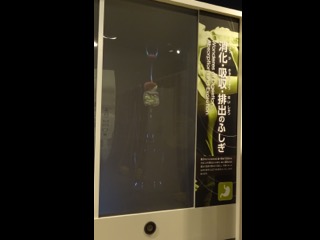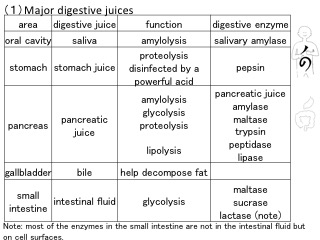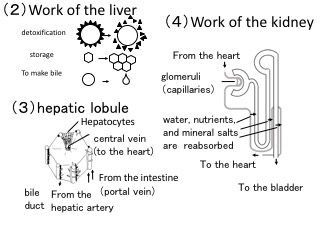Nagoya City Science Museum
TOP > Exhibition Guide > Floor Map> Wonders of Digestion, Absorption and Excretion
Wonders of Digestion, Absorption and Excretion



Purpose of Exhibition
This exhibit presents the basics about of digestion, absorption, and excretion.
The breaking down of food to obtain nutrients is called digestion, and the mechanism where absorbed nutrients are converted for use in various parts of the body and the discharge of unnecessary material from body are introduced through movie and three pieces of information about each using text and drawings on the reverse side.
(1) Gastrointestinal tract (mouth, esophagus, small intestine, large intestine)
(2) Other major digestive organs (liver, pancreas, gall bladder)
(3) Passage of absorbed nutrients (blood vessels of the small intestine, lymphatic vessels)
(4) Kidneys and bladder
Additional Knowledge
[Digestion and absorption]
Food becomes finer and decomposed as it passes through the digestive tract. The action of the gastrointestinal tract that moves food is called peristalsis. When food becomes small enough, nutrients are absorbed in the small intestine and enter blood vessels and lymph where they are transported in the body, while the water in remaining food is absorbed in the large intestine and discharged from the anus as feces.
[Digestive Juices]
Digestive juices are essential for the body to decompose food and absorb nutrients. The different organs in the digestive system secrete different digestive juices respectively. Many of them contain ingredients called "digestive enzymes" to decompose food. Listed below are the major digestive enzymes.
[How the Liver Works]
The liver can briefly be referred to as a large chemical plant in recognition of its function. The liver weighs 1.0 to 1.5 kilograms and is one of the two heaviest organs in the body. Quite a number of chemical reactions take place in the liver.
An artificial chemical reaction requires a time-consuming process of using many containers such as flasks and beakers stage by stage. In sharp contrast, the liver is capable of chemically converting a huge volume of substances in an amazingly short time by progressing simultaneously with scores of chemical reactions in the tiny cells. Now, let us show you some examples.
Three typical examples are to retain (storage) nutrients, render other substances harmless (detoxification), and create a digestive juice called bile.
First of all, for the storage of nutrients, a chemical reaction takes place to synthesize glycogen from glucose obtained by decomposing carbohydrate. When the body has a lower level of free glucose in the blood, the liver decomposes glycogen into more glucose.
In addition, the liver works to synthesize plenty of protein for normal blood clotting and to carry out decomposition as well.
What comes next from among the functions of the liver is to remove or chemically convert substances that may be harmful or toxic to the body. Decomposing alcohol is best known in this function. The liver breaks alcohol down ahead of other substances to make it harmless and non-toxic.
Furthermore, the liver produces bile, which aids in the digestion and absorption of fat. The gallbladder is the bag to store bile.
[Hepatic Lobule]
The liver is composed of thousands of roughly hexagonal columns as small units, each of which is about 1 mm in diameter and about 2 mm in height made up of numerous cells, and has a central vein in the middle. Those columns are called hepatic lobules. The lobule is the structural unit of the liver.
[Portal Vein]
The veins from all parts of the body lead to the heart. In general, the closer they get to the heart, the thicker they get. On the other hand, the vein near the liver is thick but it branches into thin veins and spreads in the liver and they get thick again away from the liver. The vein with capillaries at both ends, as mentioned here, is called "portal vein," which delivers blood to each cell in the liver to set the stage for chemical reactions. But it also functions to store the nutrients absorbed in the gastrointestinal tract to maintain a constant concentration of nutrients in the blood.
On the other hand, there is another blood vessel (hepatic artery) to deliver oxygen-rich blood to the liver, but the blood vessels that depart from the liver are hepatic veins like the portal vein.
[Alcohol and Liver]
Alcohol (ethyl alcohol) is converted in the body into acetaldehyde, which is toxic to the human body and therefore needs to be further converted into acetic acid. Among the Japanese are many of those who were born with a constitution to have difficulty in producing acetic acid in the body. When those consume alcohol, acetaldehyde remains in their bodies too long and makes them feel sick at the stomach or get intoxicated too soon with unusually fast heartbeats. So it is no exaggeration to say that an act to urge an alcoholic beverage on those may be nothing but nearly an act of violence to force them to have a poisoned drink.
Incidentally, having no innate constitution to efficiently produce acetic acid does not mean any malfunction of the liver whatsoever. On the contrary, hard drinkers have a high potentiality for developing a malfunction of the liver if they continue to drink too much over a long period of time. (Women have a higher tendency to develop a hepatic disorder on a smaller volume of alcohol in a shorter period of time than men.)
[How Kidneys Work]
he kidneys are two bean-shaped organs, each of which is about the size of an adult fist, located on either side of the spine just below the rib cage.
The kidneys produce urine to remove excess ingested water, mineral salts and body wastes from the body. The bladder is a bag to store them temporarily before excreting them in the form of urine.
There are two pairs of large blood vessels to and from the kidneys respectively. They are the renal arteries through which dirty blood flows through the kidneys and the renal veins through which clean blood leaves the kidney for the heart. Almost all the water present in the blood (about 150 liters per day) that flows through the kidneys gets out of the capillaries once. And only 1% or about 1.5 litters of the water is excreted in the form of urine. In other words, 99% of the water is recycled.
This function is called “reabsorption,” and it works to keep water and salt concentrations in our body within a certain range.
Besides the water, the salts (sodium, potassium, calcium, etc.) and sugar (glucose) get out of the bloodstream once and then are reabsorbed. On the other hand, metabolic wastes (urea, creatinine, etc.) are not usually retrieved once they are filtered out of the bloodstream. Only such wastes are excreted in the least possible amount of water urine.
[Structure of the Kidneys]
In the kidneys, the blood vessels branch outward into thin capillaries, which form into woolen yarn balls (called "glomeruli"). Each of the glomeruli is in the bowl-like end of a long tube (renal tubule) with hairpin curves. The incoming dirty blood is purified through a complex regulatory process of chemical exchange that takes place in each unit of the structure (nephron), in which a glomerulus intertwines with a renal tubule (urine collecting tube).
The cross-sections of the vertically cut kidneys show a number of units of the nephron. All the renal tubules in each kidney form into a ureter that leads to the bladder.
Article and illustrations by Tomoko Horiuchi, curator
